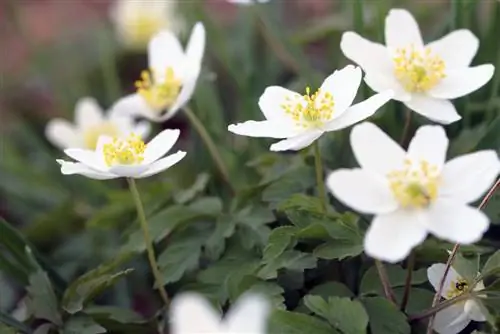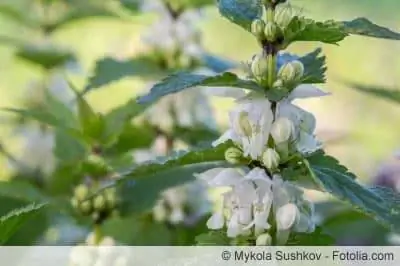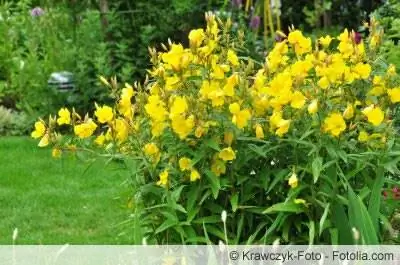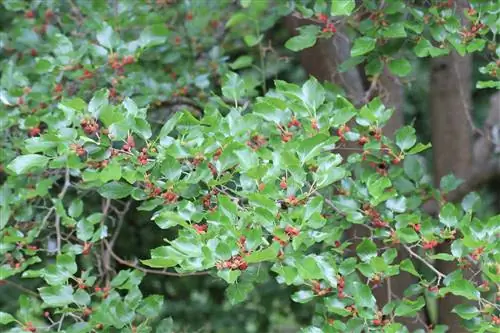- Author admin [email protected].
- Public 2023-12-17 03:39.
- Last modified 2025-01-24 12:45.
Originally found in European forests, the anemone is now very popular in many gardens. Already in the first half of spring, the white anemone shows its star-shaped leaves and enchants every garden. The easy-care, small perennial plant can thrive in almost any location in the garden and gets along with many other plants. The anemone, which reaches a height of 15 to 30 cm and withers after flowering, is therefore the ideal plant to add a little color to the early spring months.
Location
Sunny to partially shaded is the ideal place for the anemone. Since the plant prefers different lighting conditions during the day, a location under a shrub that has been pruned for the winter is ideal. Here the white anemone spreads all its flowers before the bush forms its leaves. This way the plant gets the shade and the little sun per day that it wants.
Tip:
Ideally, the anemone should be given a place where it can be in direct sun for about two hours a day, and the plant should then spend the rest of the day in partial shade or shade.
Substrate & Soil
The white anemone has relatively high demands on the soil, although it is generally easy to care for. The floor should therefore look like this:
- rich in humus and fresh
- nutrient-rich
- water permeable but always slightly damp
- A pH value of 6.5 and 7.5 is ideal, i.e. rather neutral to slightly acidic
- the anemone does not tolerate highly acidic soil
- mix in garden lime to keep the soil neutral
- For water permeability, the soil at the site can be mixed with sand or gravel
Watering & Fertilizing
The anemone always needs enough moisture; waterlogging should be avoided, as should dry soil. To ensure consistent moisture, you should water regularly until the plant has completely faded. However, care must be taken not to water the white anemone in the bright hours of sunshine; the evening or early morning hours are more suitable for this. If you already know the location for the anemones in spring in autumn, you should prepare the soil with fertilizer. The procedure is as follows:
- spread a leaf cover on the site in autumn
- so humus can form here over the winter
- In spring the soil is fertilized with compost or a slow-release fertilizer
Tip:
When lifting the compost, work carefully and pay attention to the roots and rhizomes in the soil from the previous year so that they are not damaged. If the white anemone has been in its place for many years and has spread underground, then avoid digging and use slow-release fertilizer.
Plants
Ideally, the white anemones, which are available commercially or obtained by dividing existing plants in the garden, are planted in autumn. To do this, proceed as follows:
- Place rootstocks in water about 24 hours before planting
- Dig five centimeter deep holes in the earth and insert watered rhizomes
- Dig in a rhizome barrier from the trade when planting for the first time
- maintain a distance between the planting holes of 15 to 25 cm
- cover the roots loosely with soil
- cover with autumn leaves and water lightly
- Keep the soil moist even over the winter
- If necessary, loosen the soil lightly and carefully over the winter
Tip:
Since the plant is poisonous in all fresh parts, only plant it where children or pets living in the household cannot reach it. If the above-ground parts of the plant are dead, there is no longer any danger.
Propagate
The white anemone is a perennial with rhizomes and therefore usually reproduces itself. The roots form further long shoots underground, the rhizomes, on which new plants emerge from the corner in spring. This way the plant spreads further in its location. However, if the anemone should also have a second or third place in the garden, this works well by dividing the existing plants. The division proceeds as follows:
- the ideal time is spring immediately after or during flowering, before the white anemone loses its leaves and dies above ground
- Carefully dig plants out of the ground for division
- carefully divide the plant with your hand
- plant the new plants obtained in this way at the new location
Tip:
Do not propagate plants too often through division, because the longer the anemone is left alone, the more lush it will become and bloom.
Cutting
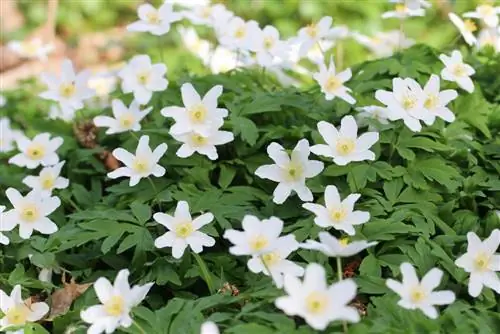
There is no need to cut the white anemone because the above-ground part of the plant wilts completely after flowering in spring. This means that only the rootstock remains in the ground for the rest of the year. If the plant parts are dead, they are simply removed and added to the compost.
Wintering
The anemone is a perennial with a rhizome and, in older plants, long rhizomes. These remain in the ground at the location over the winter. This ensures that they sprout again early in the spring.
Care errors, diseases or pests
Care errors or diseases are not known for the white anemone, but there are two pests that can affect it. Snails don't mind the plant's toxicity and therefore like to attack it. Anyone who notices eaten leaves on their anemone can assume that this is a snail infestation. Proceed as follows:
- Collect snails
- Use organic snail pellets that cannot be dangerous to other animals such as hedgehogs
The anemone cup can also attack the plant:
- lives as a parasite on the anemone
- This is a fungus that feeds on the roots of the plant
- recognizable by the thread-like cells that extend far into the ground
- this can be counteracted with fungicides from the trade
Conclusion
The anemone is a plant that, in the ideal location, offers the hobby gardener beautiful white flowers early in the year. If it has been planted correctly in the garden and combined with plants that bloom later, garden lovers can expect a colorful garden from early spring onwards. Since the white anemone dies above ground after flowering, it is also suitable as a splash of color under a winter-bare tree that only forms its green leaves after the anemone has flowered. In this way, a flowering and green carpet can be created under winter-bare trees in early spring for many years.

